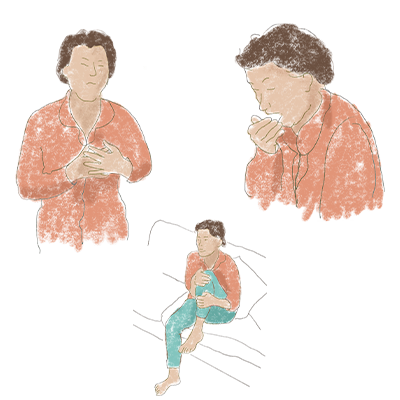Systemic mastocytosis (SM) is a rare disease that occurs when too many mast cells build up in your body.1–4
What is a mast cell?
Mast cells are a type of white blood cell.5 Everyone has mast cells in their body, and they play important roles in our immune system in keeping us healthy, such as protecting us from infection.6 However, mast cells are also involved in allergic reactions.5,6 When the body has too many mast cells, signs and symptoms that are similar to those seen in allergic reactions appear.5 In people with SM, excess mast cells build up in one or more of their organs, such as skin or bone marrow.5,7 This helps to explain the different symptoms affecting the different parts of the body.5
SM mainly occurs in adults.8 Around 1 in 10,000 adults have SM.9* People that have SM may start to notice effects of it at 20–50 years of age.3
*Based on a Swedish cohort of 195 adults with SM diagnosed in 2006–2020.9
People with SM may experience rash, tiredness, loose/watery stools, a life-threatening allergic reaction called anaphylaxis, as well as various symptoms that can worsen over time.1,2 It is important to diagnose SM as early as possible so that it can be managed appropriately.
If you think you have symptoms of SM, consult your doctor for an adequate diagnosis and ask any questions you might have about your symptoms and SM.
Causes of SM
Most cases of SM are caused by a mutation (or a random change) in the gene called ‘KIT’, which is responsible for the growth of mast cells.3,4 This change leads to too many mast cells being produced.1,3,4,5 Typically this condition is not inherited.5
These mast cells build up in tissues and organs around your body, releasing substances (also known as mediators) that cause a range of symptoms, some of which might seem like those of an allergic reaction.5
SM can be diagnosed in multiple ways, including through diagnostic testing to detect a KIT gene mutation. Learn more about this here and ask your doctor any questions you might have.
There are two main types of SM that can be further broken down into six subtypes:10,11
The symptoms and impact of SM can vary depending on the type:
Non-Advanced SM
BMM is a rare subtype, which involves mast cells building up in the bone marrow only.3
ISM is the most common subtype of SM and is generally less severe than the others. In ISM the mast cells build up slowly, mainly in the bone marrow, but also in other areas of the body like the skin. Symptoms of ISM may include rashes, headache and nausea.3,8
In SSM, the mast cells grow a bit faster than in ISM, but it does not usually lead to severe symptoms.3,7,8 However, it is still important to keep track of any changes over time.
Advanced SM
ASM is a more serious subtype where mast cells grow rapidly leading to organ damage. Patients can experience significant symptoms, including weight loss, an enlarged spleen or liver, and bone pain.8,12
MCL is the rarest and most severe subtype. The bone marrow becomes overwhelmed with abnormal mast cells, leading to organ dysfunction.3,7,8
SM-AHN is the name for when SM occurs alongside another malignant condition that affects the blood cells.8 It may lead to organ damage, but the severity depends on the other blood condition you have.3,8 Careful monitoring and treatment is required to manage both conditions effectively.

